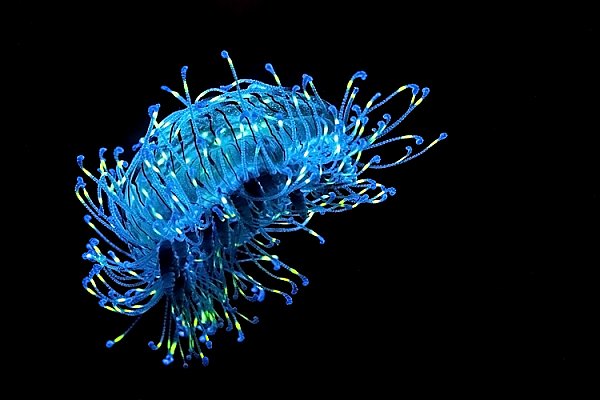Flower Hat Jelly
Olindias formosus
This stunning fluorescent jelly has a translucent bell with dark, opaque pinstripes. Lustrous, multicolored, fluorescent-tipped tentacles trail from its bell, while others are coiled up close to their bodies, making them appear short. Flower hat jellies are nocturnal and remain on or close to the sea bottom during the day. They are found off of southern Japan, Argentina, and Brazil. A part of their life cycle has recently been observed for the first time.

SPECIES IN DETAIL
Flower Hat Jelly
Olindias formosus
CONSERVATION STATUS: Data deficient
CLIMATE CHANGE: Not Applicable
At the Aquarium
Flower hat jellies are on display in the Northern Pacific Gallery across from the Diving Birds exhibit.
Geographic Distribution
Flower hat jellies are found off southern Japan, Argentina, and Brazil.
Habitat
These jellies typically live near the ocean floor close to kelp or seagrass.
Physical Characteristics
Flower hat jellies have a translucent bell with dark, opaque pinstripes radiating from the top center to the edge. Lustrous, multicolored, fluorescent- tipped tentacles trail from the bell, with others coiled up close to their bodies, making them appear short. They appear to light up like fireworks under a black light.
Size
This species’ bell size can be up to 6 inches (15 centimeters) wide.
Diet
These jellies feed on small fish captured with their tentacles.
Reproduction
Because these jellies are bottom dwellers, it has been difficult to observe them and learn about their life cycle. It is not known what triggers gamete release and how fertilized gametes develop into larvae and then stalk-like polyps. Typically jelly larvae will attach themselves to a solid substrate and then become polyps. It was recently discovered that this jelly’s polyp is unusual, as it has one very active tentacle, and the polyps have been observed under black light in some aquarium exhibits budding off new jelly medusae.
Behavior
This is a nocturnal species, remaining on or near the sea bed during the day.
Longevity
This jelly lives for four to six months.
Conservation
This species has not been evaluated by the International Union for Conservation of Nature. Flower hat jelly blooms in Brazil have interfered with shrimp fishing by clogging the nets and driving away the shrimp.
SPECIES IN DETAIL | Print full entry
Flower Hat Jelly
Olindias formosus
CONSERVATION STATUS: Data deficient
CLIMATE CHANGE: Not Applicable
Flower hat jellies are on display in the Northern Pacific Gallery across from the Diving Birds exhibit.
Flower hat jellies are found off southern Japan, Argentina, and Brazil.
These jellies typically live near the ocean floor close to kelp or seagrass.
Flower hat jellies have a translucent bell with dark, opaque pinstripes radiating from the top center to the edge. Lustrous, multicolored, fluorescent- tipped tentacles trail from the bell, with others coiled up close to their bodies, making them appear short. They appear to light up like fireworks under a black light.
This species’ bell size can be up to 6 inches (15 centimeters) wide.
These jellies feed on small fish captured with their tentacles.
Because these jellies are bottom dwellers, it has been difficult to observe them and learn about their life cycle. It is not known what triggers gamete release and how fertilized gametes develop into larvae and then stalk-like polyps. Typically jelly larvae will attach themselves to a solid substrate and then become polyps. It was recently discovered that this jelly’s polyp is unusual, as it has one very active tentacle, and the polyps have been observed under black light in some aquarium exhibits budding off new jelly medusae.
This is a nocturnal species, remaining on or near the sea bed during the day.
This jelly lives for four to six months.
This species has not been evaluated by the International Union for Conservation of Nature. Flower hat jelly blooms in Brazil have interfered with shrimp fishing by clogging the nets and driving away the shrimp.

